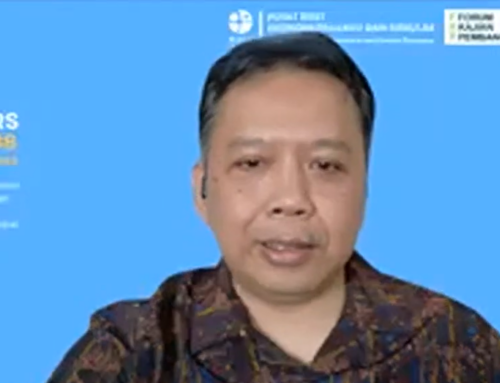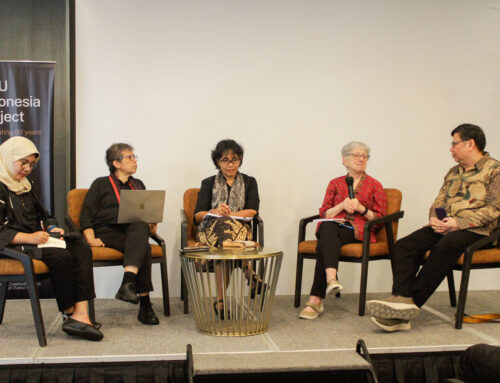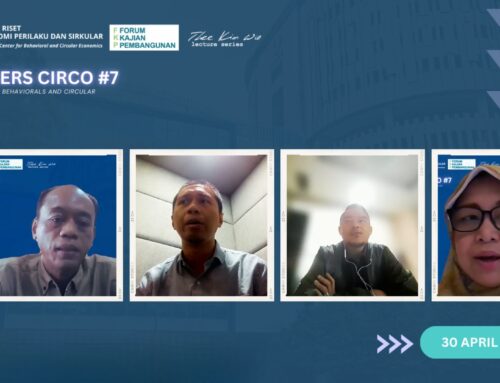FKP hosted by National Research and Innovation Agency (BRIN) with Dr Iwan Hermawan (Research Center for the Economics of Industry, Services, and Trade, BRIN) and Dr Phanida Roidoung (Public debt management Office, Ministry of Finance, Thailand). Tuesday, 26 April 2022.
KEY POINTS:
- As the COVID-19 pandemic enters a phase of controlled spread, policymakers face the challenge of steering the economy back to the normal track. International trade plays an essential role in improving the economy in Indonesia, and the contribution of the trade sector to the Indonesian economy has increased over the past decade, including throughout the pandemic. Even Indonesia’s balance of trade in 2021 was the highest compared to the previous decade. The export performance of several non-oil and gas commodities showed a significant rebound after the pandemic, resulting in a trade balance surplus until 2021. However, it is necessary to be wary because the trend of imports is also increasing.
- COVID-19 poses many challenges to the important role of Thailand’s fiscal policy for economic and social recovery. In 2021 the COVID-19 emergency decree allocates 500 billion baht to support public health and the economy. Thailand still faces challenges to restore the tourism industry. The risks and obstacles to tourism recovery are still challenging, especially given the new wave of COVID-19 cases and vaccine management. Challenges also come from fiscal conditions, where debt-to-GDP ratios and debt affordability must be carefully maintained. Despite these challenges, Thailand has mobilized an innovative suite of fiscal support for the tourism sector.
SUMMARY
- As the COVID-19 pandemic enters a phase of controlled spread, policymakers face the challenge of steering the economy back to the normal track. Dr. Iwan Hermawan from BRIN discussed the power of trade to support economic growth after the pandemic.
- The COVID-19 pandemic has shrunk the size of global trade by 10% and GDP by 3%. The worst impact of the COVID-19 pandemic was experienced by low-middle income countries. The relationship between trade openness and economic growth is shifting. Before the COVID-19 pandemic, the two seemed to have a positive relationship, but it was different during the COVID-19 pandemic. Many countries tend to retreat to autonomy to prioritize their domestic conditions.
- For Indonesia, the contribution of trade to the Indonesian economy has increased over the past decade. Perhaps contrary to expectations and the international experience, Indonesia’s balance of trade in 2021 was the highest in the past decade. The improvement in the balance of trade in 2020-2021 was contributed by non-oil and gas commodities, and because of a sharper decline in imports compared to exports. The decline in imports was due to the suspension of infrastructure projects during the early days of the COVID-19 pandemic, which required heavy equipment and construction materials (iron, steel, and base of metal imports decreased 17-50%). Textile and garment imports also fell sharply. The United States, India, and the Philippines are the three most significant contributors to Indonesia’s trade surplus. Meanwhile, the countries that made Indonesia’s trade deficit came from China, Australia, and Singapore.
- Many agricultural commodities have become winning items (products that sell a lot) in world markets before and even during the COVID-19 pandemic, such as fish, rubber, coffee, animal or vegetable fats and oils, and palm oil. Manufacturing commodities have not changed much in their competitiveness before and during Covid-19. Indonesia has great potential benefits from exporting to traditional export markets. COVID-19 also has increased expansion into new export markets, such as several neighboring countries, Africa, and South America
- Indonesian trade plays an essential role in improving the economy. The export performance of several non-oil and gas commodities showed a significant rebound after the pandemic, resulting in a trade balance surplus until 2021. However, it is necessary to be wary because the trend of imports is also increasing. The competitiveness of several primary commodities has shown an increase, especially agricultural commodities, compared to manufacturing. The export destination market is also wide open, not only in traditional markets.
- Trade, specifically trade liberalization, is not the single solution for improving economic conditions. A combination of policies/programs related to increasing national production capacity and international cooperation is needed. Strengthening the role of trade on economic growth during the pandemic (including the endemic) still leaves homework, one of which is relying on trade with digital technology and the momentum of environmental perspective.
- Dr. Phanida Roidoung (Public debt management Office, Ministry of Finance, Thailand) discussed the post-COVID-19 challenge on the crucial role of Thailand’s fiscal policy for economic and social restoration. In Thailand, the Government is the only potential player to drive the economy during the pandemic. Thailand’s COVID-19 relief and stimulus package was carried out to help the economy survive the pandemic. In 2021 COVID-19 emergency decree allocated 500 billion baht to support medical and public health, rehabilitate and compensate affected people and SMEs to retain their employment, maintain employment levels and stimulate short-term consumption and small infrastructure project investment.
- The tourism business in Thailand has been affected since the outbreak of COVID-19. The government mobilized several interventions primarily directed to the tourism sector, including:
- extending the debt payment period, relaxed term loans to tourism entrepreneurs, and postponed rental payment of state property for tenants in the tourism sector;
- providing soft loans to tourism entrepreneurs through the Government Saving Bank;
- providing subsidies to domestic travelers (flight subsidy, accommodation subsidy, etc) to undertake travel to various destinations throughout the country in order to create jobs, generate income, enhance liquidity and stimulate consumption.
- Thailand still faces the challenge of recovering the tourism industry. The risks and obstacles to tourism recovery still haunt, especially the new wave of COVID-19 cases and vaccine management. Challenges also come from fiscal conditions, where the debt-to-GDP ratio and debt affordability must be carefully maintained.





